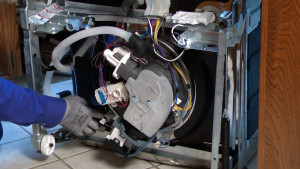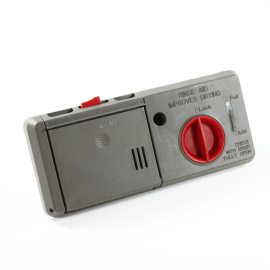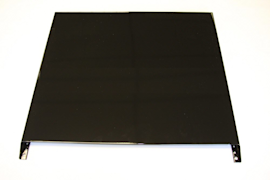- Kenmore refrigerator water filters
- Whirlpool refrigerator water filters
- Samsung refrigerator water filters
- GE refrigerator water filters
- LG refrigerator water filters
- Frigidaire refrigerator water filters
- KitchenAid refrigerator water filters
- Maytag refrigerator water filters
- Kenmore Elite refrigerator water filters
- Estate refrigerator water filters
- GE Profile refrigerator water filters
- Amana refrigerator water filters
- Bosch refrigerator water filters
- Dacor refrigerator water filters
- Electrolux refrigerator water filters
Can’t find your part? Contact us: +1-309-603-4777
Top DIY repair help
View All Repair Categories
Appliances
Lawn & Garden
Power Tools
Home Improvement
Sports & Leisure
Heating & Cooling
OrdersSchedule a repair
Keep track of the models you own in your profile
Sign in or Register to view or add models
Dishwasher leaks video

If your dishwasher leaks, the problem may be with a damaged door seal, a cracked or clogged spray arm or components under the dishwasher. This Sears PartsDirect video shows you how to access all of those areas, find the source of the leak and fix it to get your dishwasher working again.
Check out our DIY Dishwasher Repair help section for symptoms and troubleshooting tips, error code charts, repair guides and more.
Tools or parts needed
Screwdriver
Adjustable wrench
Container or pitcher to scoop water
Wet/dry shop vacuum
Work gloves
Check door seal, spray arms for damage
Hi, Wayne here from Sears PartsDirect. Today we're going to talk about what to do when your dishwasher leaks. If you see water leaking from the door, open the door and check the gasket, also called a door seal. If you see tears or pieces of the door seal missing, replace it. Here's a video that shows you how.
If the door seal is okay and the water leaks only from the bottom of the door, the problem could be that a cracked spray arm or a loose tube is creating a wave action inside the tub. The wave action will slosh water over the front lip of the tub and drip out the bottom of the door.
First open the dishwasher door and check that no dishes are blocking the spray arm so it can’t rotate fully. If the spray arm can rotate fully and isn’t cracked, check the tube connection on the pump’s water outlet opening. Spray at a loose connection can also create a wave action.
To check the connection, open the dishwasher door and remove the bottom dishrack. Release and remove the bottom spray arm. Refer to your owner's manual for directions on how to remove the spray arm if it’s different from this model. Reconnect the tube if the connection is loose. If your dishwasher is a Kenmore with the TurboZone spray arm, check the TurboZone feed tube as well.
Some dishwasher pumps have an outlet that screws on top of the pump. If you have this type of dishwasher, make sure those screws are tight. The screws in this type of pump can work loose over time. When the screws get loose, water shoots through the side of the pump outlet, creating wave action that can cause a leak.
If you can’t find the cause of the leak, we recommend having a Sears service technician examine the dishwasher. The technician may need to run the dishwasher with internal components exposed. Only a service technician with adequate training should preform these checks due to the risk of electrocution.
Check water supply line, drain hose
Next, let’s talk about leaks under the dishwasher. You may not notice these until after they start damaging your cabinet. You might find the leak under adjacent cabinets, such as under the kitchen sink cabinet. Sometimes, water may seem to be leaking from the bottom of the door when it's actually leaking under the dishwasher and pooling beneath the door.
To find the leak, first disconnect the electrical power by unplugging the dishwasher or shutting off the house circuit breaker for the dishwasher. Then remove the bottom front service panel and toe panel by removing the mounting screws and then pulling off both panels so you can see under the tub. On many dishwasher models, you can remove the front door panel and control panel to see and reach the bottom components better.
Open the dishwasher door and remove the Torx screws from the outer edges of the inner door panel. Support the outer door panel with one hand as you remove the final screws so it doesn't fall. Separate the outer door panel and control panel slightly from the inner door panel, and let the outer panel rest on the floor while you disconnect the user interface control wire harness. Pull off the outer door panel and control panel.
Check the water supply line connection at the front of the dishwasher first. If you find that connection leaking, tighten the fitting to see if that stops the leak. If not, shut off the water supply and place a towel under the water supply line connection. Disconnect the supply line and replace the connection seal. If the water supply line connection isn't leaking, check the drain hose connection to the drain pump for drips or other evidence of leaking such as a water trail or water stains. Reconnect the drain line if it’s loose.
If the drain hose isn't leaking, use a flashlight to look under the dishwasher for evidence of leaks. You may see the water dripping or a water trail indicating the location of the leak. If you find the source of the leak, replace the leaking seal or component.
Examine heating element, pump and diverter motor
If you didn’t find the source of the leak, you’ll have to pull the dishwasher out from under the counter. For safety, make sure that you have electrical power disconnected from the dishwasher. Shut off the water supply to the dishwasher and release the drain hose from the garbage disposal or sink drain connection. Place a towel under the water line connection on the water inlet valve. Disconnect the water line and wipe up any spilled water. If the power cord plugs into an electrical outlet, position the power cord so it moves freely when you pull the dishwasher out from under the counter.
If your power cord doesn't plug into an electrical outlet, then the power cord is hard-wired into the junction box. Remove the junction box cover and disconnect the supply wires. Remove the strain relief nut to release the power cable from the junction box. Position the door panel and control panel close enough to the inner door so you can reconnect the user interface control wire harness and attach the outer door panel and control panel to the inner door panel. Reinstall the mounting screws.
Remove the bottom dishrack to avoid damaging interior parts when you tip the dishwasher over to examine for leaks. Remove the screws from the mounting brackets that hold the dishwasher under the counter. Carefully pull the dishwasher out and lay it on its back so you can see all of the bottom components. Check for water trails or other evidence of leaking from the bottom components, such as the heating element, sump or diverter motor. Replace any component that’s leaking.
If the component has a seal that you can purchase separately, replace the seal instead of the whole thing. If you don’t see a water trail or evidence of leaks, set the dishwasher upright. Fill the tub with some water to see if you can find the source of the leak now that you have a better view of the bottom components. Pour a quart of water into the tub. Check for water dripping from any components under the tub. Continue adding water and checking for leaks until you fill the tub to the bottom of the mushroom float. You'll likely find the source of the leak using this process. Keep a wet/dry shop vac or container handy to remove the water from the dishwasher once you find the source of the leak. Once you find the leak, remove the water and replace any leaking components or seals.
Technician needed for further tests
If you still can’t find the leak, then the faulty component may only leak when the pump sprays water. Have a Sears service technician find this leak because the technician will likely check for leaks with the dishwasher running and with wiring and electrical components exposed. Only a service technician should run the dishwasher in this condition because exposed wiring and components are an electrocution risk.
I hope this video helped you out. You can find links to the parts we talked about in the video description. Check out our other repair videos here on the Sears PartsDirect YouTube channel. Subscribe and we’ll let you know when we post new videos.
Was this information helpful?
Most common symptoms to help you fix your dishwashers
Choose a symptom to see related dishwasher repairs.
Main causes: broken door spring, damaged or broken door hinge…
Main causes: not using rinse aid, rinse aid dispenser failure, broken heating element, malfunctioning vent, drying fan f…
Main causes: water supply problem, stuck overfill float, clogged water inlet valve screen, water inlet valve failure…
Main causes: light switch beside the sink turned off, lack of power, bad dishwasher door switch, control system failure,…
Main causes: improper loading, low water temperature, improper detergent dosage, detergent dispenser failure, spray arm …
Main causes: glass or popcorn kernel stuck in the chopper blade, drain line vibrating against the cabinet, debris in was…
Main causes: clogged kitchen sink drain, clogged drain hose, drain check valve damaged, drain pump failure, control syst…
Main cause: damaged rack height adjuster…
Main causes: damaged or stuck spray arm, leaking door seal, damaged door hinge, leaky heating element water seal, cracke…
Most common repair guides to help fix your dishwashers
These step-by-step repair guides will help you safely fix what’s broken on your dishwasher.

How to replace a dishwasher water inlet valve
If your dishwasher fills constantly or won't fill at all, the water inlet valve has failed. You can replace it in about …
Repair difficulty
Time required
30 minutes or less

How to replace a dishwasher detergent dispenser
Dishes need dish detergent to get clean. Learn how to replace a dishwasher detergent dispenser with easy step-by-step i…
Repair difficulty
Time required
30 minutes or less

How to replace a dishwasher door outer panel
If your dishwasher door is dented or you want it to match your cabinets or other appliances, this guide shows how to rep…
Repair difficulty
Time required
15 minutes or less
Effective articles & videos to help repair your dishwashers
Use the advice and tips in these articles and videos to get the most out of your dishwasher.

Get tips on completing essential holiday cleaning tasks to brighten your home.…

Learn about all the convenient features on our Sears PartsDirect website that make your parts purchases easier.…

Get answers to frequently asked questions about Sears and Sears PartsDirect.…
Parts & More
Parts
Pump T Ser TN-CLLA-CLLA-JFBX0rd Prts Req VEP0848AR-CHIP,365 2007-010412Coil Condnsr 373-02762-000Case Assy,ca X49212611Bushing 518481003Handle 47924Carburetor 580-61090-00Door Glass W10915038Button DW-1200-09Counter Assembly 141-0-8119-01000Cone Spkr Ts 231-67ASolenoid DB33-00002GHome Electronics Case VSCS0050Belt 8015L960Home Electronics Shield 126-02676-01Base 5304492063Home Electronics Panel 4A16324Home Electronics Battery Cover 211571901Home Electronics Control VRV0028